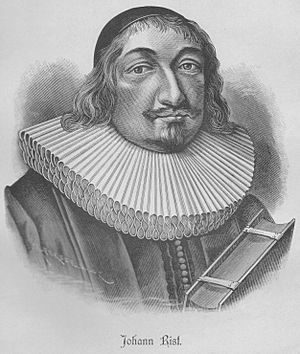Johann Rist facts for kids
Johann Rist (born March 8, 1607 – died August 31, 1667) was a German poet and writer. He is most famous for his hymns, which are religious songs. Many of his hymns were set to music and are still sung in churches today.
Contents
Early Life and Education
Johann Rist was born in a place called Ottensen, which is now part of Hamburg, Germany. His father, Caspar Rist, was a Lutheran pastor. From a young age, Johann received a good education. He first attended the Gelehrtenschule des Johanneums in Hamburg. Later, he studied at the Gymnasium Illustre in Bremen.
After his early schooling, Rist went to the University of Rinteln to study theology. This is where he became very interested in writing hymns. After leaving Rinteln, he worked as a private teacher for the sons of a merchant from Hamburg. He traveled with them to the University of Rostock. There, he continued his own studies, learning about Hebrew, mathematics, and medicine.
During his time in Rostock, a big war called the Thirty Years War was happening. This war caused many students to leave the university. Johann Rist himself became very sick with a disease called pestilence, but he recovered.
Life as a Pastor and Family
In 1633, Johann Rist became a tutor for Heinrich Sager's family in Heide, Holstein. Two years later, in 1635, he became the pastor of the village of Wedel, which is located near the Elbe River. He stayed in Wedel for the rest of his life.
In 1633, he married Elisabeth Stapel. They had five children together, but sadly, two of them died young. Elisabeth passed away in 1662. In 1664, Johann Rist married again to Anna Hagedorn, who was the widow of his friend Phillipp Hagedorn. Johann Rist died in Wedel on August 31, 1667.
Writing Plays and Poetry
Johann Rist first became known for his play called Perseus, which he wrote in 1634. Over the next few years, he wrote several other plays. Two of his most interesting plays are Das friedewünschende Teutschland (1647) and Das friedejauchzende Teutschland (1653). These plays were allegories, which means they used characters and events to represent deeper ideas, often about peace.
Rist soon became a very important figure among other poets. The emperor Ferdinand III recognized his talent. In 1644, the emperor crowned him a "laureate," which is an honor given to a poet for their achievements. In 1653, the emperor made him a nobleman and gave him the title of a Count Palatine. This special honor allowed Rist to crown other poets.
He used this power to gather many poets for a literary society he started in 1660. It was called the Elbschwanenorden (Order of Elbe Swans). Before this, he had also joined other literary groups. In 1645, he became a member of the Pegnitz society, where he was known as Daphnis aus Cimbrien. In 1647, he joined the Fruchtbringende Gesellschaft ("Fruitbearing Society") and was known as Der Rüstige.
Writing Church Hymns
Johann Rist is most famous for writing church hymns. Many of his hymns are still used in Protestant hymn books today. Some well-known examples include "O Ewigkeit, du Donnerwort" and "Ermuntre dich, mein schwacher Geist". He published collections of his poems and hymns, such as Musa Teutonica (1634) and Himmlische Lieder (1643).
The famous composer Johann Sebastian Bach used Rist's hymns in his music. For example, Bach composed two cantatas based on Rist's hymn "O Ewigkeit, du Donnerwort." A cantata is a type of musical piece for voices and instruments. Bach's BWV 60 (1723) used the first verse of the hymn, and his chorale cantata BWV 20 (1724) used the entire hymn.
Another one of Bach's chorale cantatas, Jesu, der du meine Seele, BWV 78, is also based on a hymn by Johann Rist with the same name. Rist's hymn "O Gottes Geist, mein Trost und Rat" is sung to the tune of another hymn called "Komm, Heiliger Geist, Herre Gott".
One of Rist's hymns from 1641 or 1642, called "Ein trauriger Grabgesang," is interesting because it contains the phrase "God is dead" in German culture. In this hymn, the phrase is used in a Christian way, meaning that Jesus, who is God, died on the cross. The text says:
O große Not!
Gott selbst ligt tot,
Am Kreuz ist er gestorben.
This translates to: Oh great need! God himself lies dead, On the cross he died.
Works
- Die alleredelste Belustigung (1666)
- Die alleredelste Erfindung (1667)
- Das alleredelste Leben (1663)
- Das alleredelste Nass der gantzen Welt (1663)
- Das Friedewünschende Teuschland (1649)
- Sabbathische Seelenlust. Lüneburg: J. and H. Stern 1651
- Neue Musikalische Fest-Andachten: Lüneburg: J. and H. Stern 1655
- Neue Musikalische Katechismus-Andachten. Lüneburg: J. and H. Stern: 1656
- Himmlische Lieder. Lüneburg: J. and H. Stern 1641
- Neue Musikalische Kreutz- Trost- Lob und DankSchule. Lüneburg: J. and H. Stern 1659
See also
 In Spanish: Johann von Rist para niños
In Spanish: Johann von Rist para niños


